Landscape was ranked fourth in order of importance out of five genres in western art. However, several Impressionist artists devoted most of their careers to studying and painting the landscape. Since then, landscape has become a major theme in western art. Pierre-Auguste Renoir (February 25, 1841 – December 3, 1919) explored landscape painting throughout his career. Initially, he created works which were naturalistic representation through direct study from nature. This may be seen in the first painting on our list. Renoir, in late 1860s, became one of the pioneers of the art movement Impressionism and it was in landscape painting that he performed his most audacious experiments in light, color, form and brushwork. He also began working en plein-air (“open air”), the practice of painting outdoors to capture the effects of light and atmosphere. Renoir’s style changed in the 1880s but he continued to create landscapes and push the boundaries of the genre. Here are 7 beautiful landscape paintings by Pierre-Auguste Renoir including his Impressionist masterpieces in the genre.
#1 Jules Le Coeur Walking in the Fontainbleau Forest with his Dogs
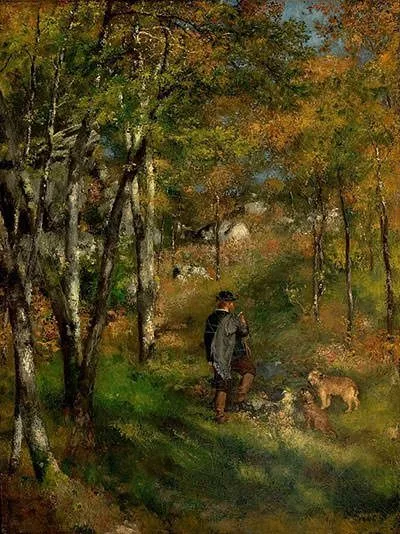
| Location: | Assis Chateaubriand Art Museum (MAC), Campina Grande, Brazil |
| French Title: | Le peintre Jules Le Coeur et ses chiens dans la forêt de Fontainebleau |
| Year: | 1866 |
At the time this work was created, forest of Fontainebleau was a popular site of recreation. The forest, with its dense vegetation and rock-studded hillocks, became a favorite subject for painters and photographers. Renoir painted several works depicting the forest among which this is the best known. It depicts his friend Jules Le Coeur as he climbs a grass-covered path in the dense forest. The painting was created by Renoir before his Impressionist period and has been executed in the Realism style.
#2 The Duck Pond
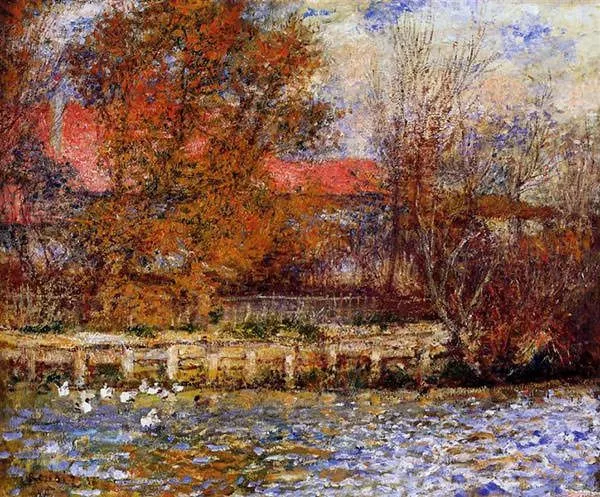
| Location: | Dallas Museum of Art, Texas, United States |
| French Title: | L’étang de Canard |
| Year: | 1873 |
Renoir painted with Claude Monet in the summer of 1873. The two artists had collaborated earlier and did so on several future occasions. On one excursion during the summer, Renoir painted two landscapes and Monet completed one. The paintings they created are often compared to point out the differences between the two artists. The Duck Pond is one of those three paintings. The scene captured in the painting remains unknown though it is most likely in the region of Argenteuil, where Monet lived.
#3 The Skiff

| Location: | The National Gallery, London, England |
| French Title: | La Yole |
| Year: | 1875 |
This painting includes several of the motifs typically identified with Impressionism like fashionably dressed women and boating. Like the choice of the subject, the painting technique is also characteristically Impressionist, especially Renoir’s use of color. The artwork is dominated by the contrast between orange of the boat and blue of the water. The shimmering play of light is captured by Renoir through a dense mesh of strokes, distinct in the foreground but softer for the trees in the background. Though not known with certainty, the scene depicted is probably Renoir looking at the Seine River near Chatou.
#4 Woman with a Parasol in a Garden

| Location: | The Thyssen, Madrid, Spain |
| French Title: | Femme Avec Parasol Dans un Jardin |
| Year: | 1875 |
Created at the height of his Impressionist style, this painting was created in the garden of Renoir’s new studio in Montmartre. Also known as Summer Landscape, the painting depicts a woman with an umbrella and her partner, who is bending down to pick up a flower. The tone, themes and visual language of the canvas are wholly Impressionistic. The flowers and shrubs are created with tiny dabs of color while the forms intermingle. The figures can be distinguished by their dark clothing, which matches with the dark vegetation to their right.
#5 Fog on Guernsey
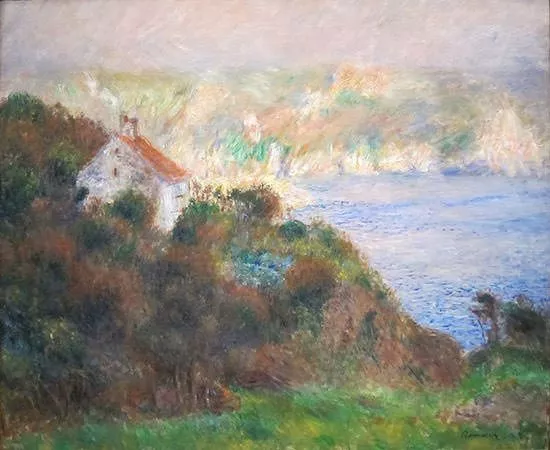
| Location: | Cincinnati Art Museum, Ohio, United States |
| French Title: | Brouillard à Guernsey |
| Year: | 1883 |
In the summer of 1883, Renoir visited the British island of Guernsey. During his visit, Renoir painted about fifteen views of the bay and the beach of Moulin Huet, on the island’s rocky southern coast. Perhaps the best known work among them is Fog on Guernsey. The scene, especially the background, is blurry. This shows his Impressionist technique while at the same time it captures the effect of the fog. Fog on Guernsey is often compared to Monet’s “Fisherman’s Cottage on the Cliffs at Varangéville” of 1882. The paintings are similar in structure but the color palette and the way in which paint is applied in Fog on Guernsey are in keeping with Renoir’s style.
#6 Lakeside Landscape
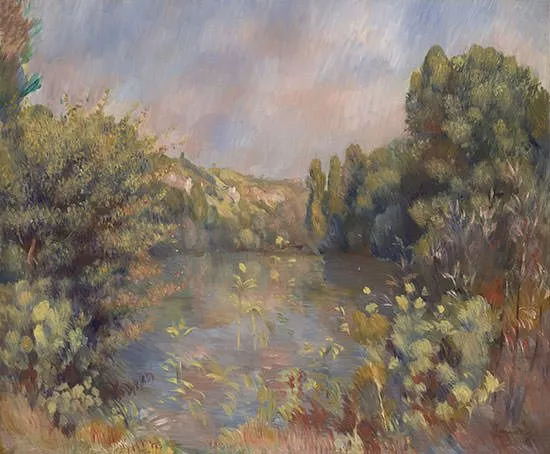
| Location: | The National Gallery, London, England |
| French Title: | Paysage au Bord du Lac |
| Year: | 1889 |
Though its exact location is not known, the landscape depicted in this painting is near Annecy, a town adjacent to a large lake in the Haute-Savoie region of France. In keeping with his landscape art, Renoir has used strong color combination in the work, offsetting the bright greens with contrasting shades of red. The artist has used blurring to make the viewer feel that he is looking deeper into the picture. The influence of Paul Cezanne may be seen in Renoir’s usage of short, intense brushwork describing the trees and foliage in the right background.
#7 The Farm at Les Collettes, Cagnes
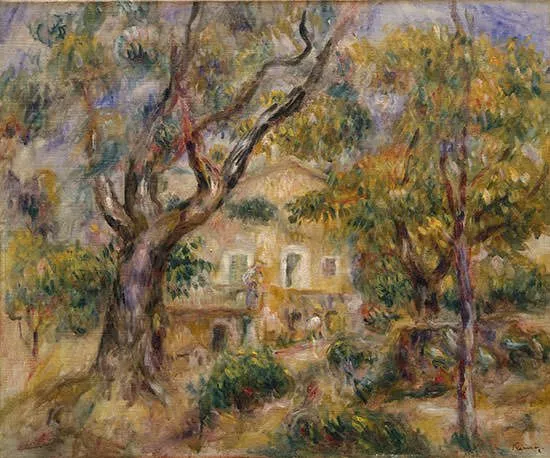
| Location: | Metropolitan Museum of Art, New York City, USA |
| French Title: | La Ferme des Collettes |
| Year: | 1914 |
In 1908, Renoir moved to the farm in Cagnes-sur-Mer on the Mediterranean coast of Southern France. The artist created several paintings of the picturesque farmhouse, its groves of olive and orange trees, and the views it afforded of the hilly countryside. This paintings is one of many to capture the farmhouse surrounded by olive trees. It is to be noted that it shows the original farmhouse and not the architect-designed house in which Renoir lived. The Farm at Les Collettes is a prime example of the late landscapes created by the artist.

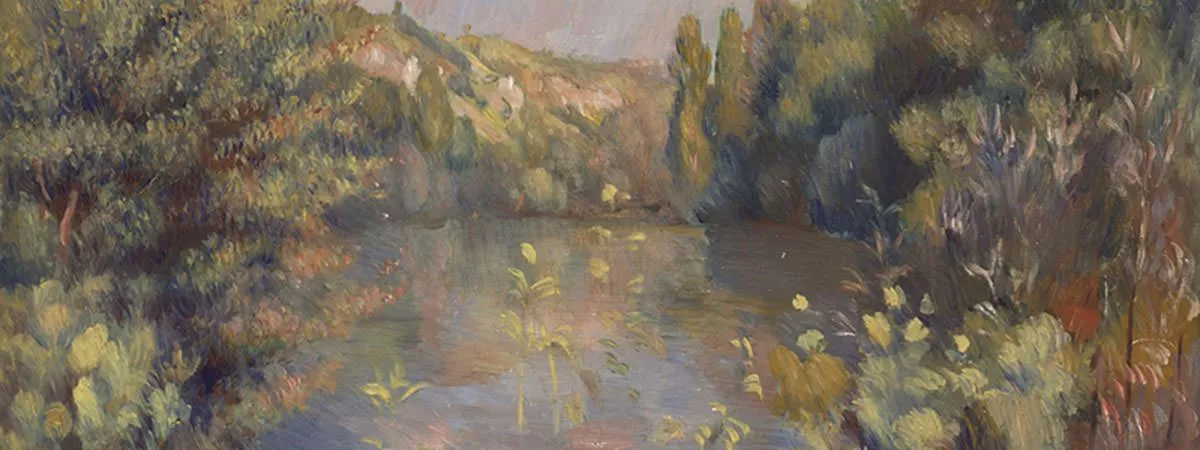
R there any lithographs of these landscapes available for purchase? Is so, would u provide a link?
THANK YOU SO MUCH. I enjoy visiting your wonderful site.
You’re welcome.